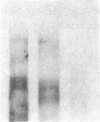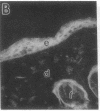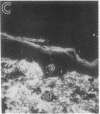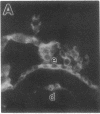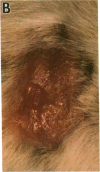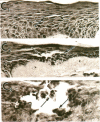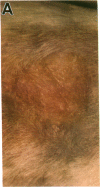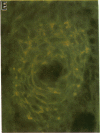Abstract
Pemphigus vulgaris is an autoimmune blistering disease that is induced by binding of antibodies to a 130/85-kD protein complex on epidermal keratinocytes. An in vivo experimental model of this disease was developed by reconstituting severe combined immunodeficiency (SCID) mice with 1-10 x 10(7) PBL from patients with naturally occurring pemphigus vulgaris. Of 49 reconstituted mice, 34 (69%) produced human IgG levels of > 0.1 mg/ml. Circulating anti-pemphigus antibodies were found in 20 of the 34 successfully reconstituted mice; 44% of these animals had deposits of human IgG in their own skin after it was traumatized by either heat or cold. Spontaneous pemphigus vulgaris-like blisters associated with human IgG deposits were rarely found in mouse skin. By contrast, allogeneic human skin grafted to 10 to 12 mice before reconstitution with patients' PBL developed pemphigus vulgaris-like lesions containing human IgG deposits. These results demonstrate that SCID mice can serve as a model of an antibody-mediated human autoimmune skin disease.
Full text
PDF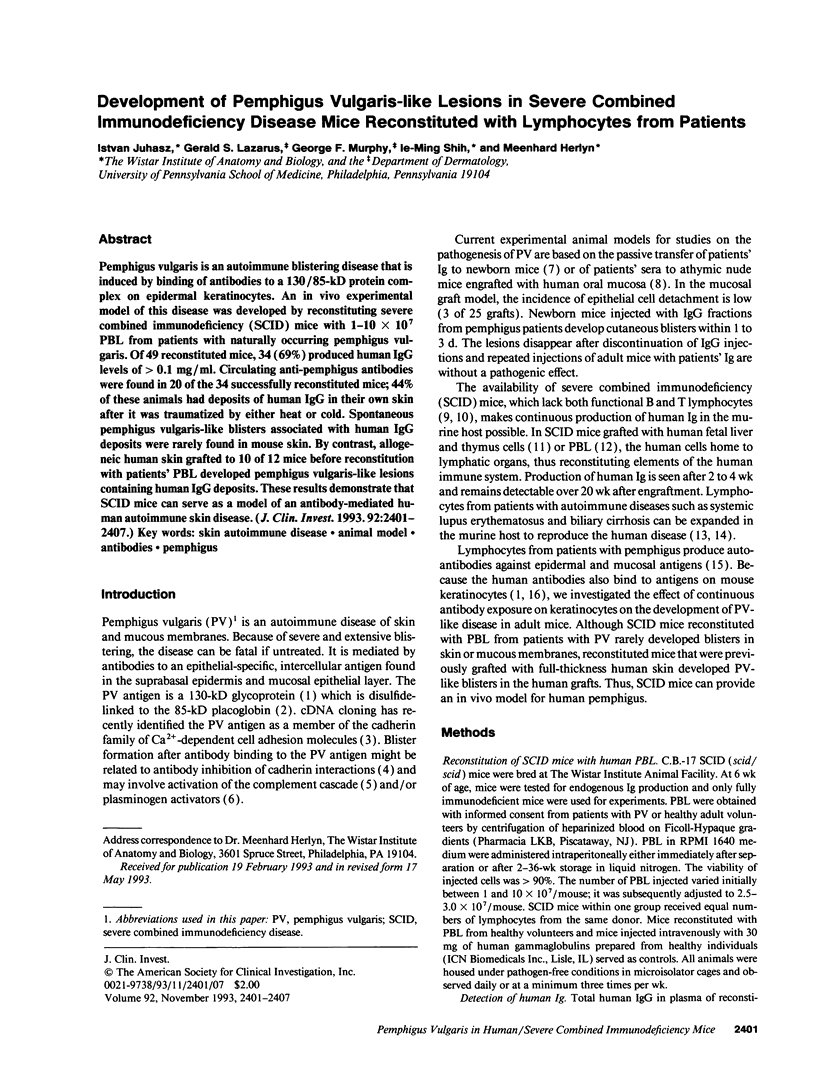
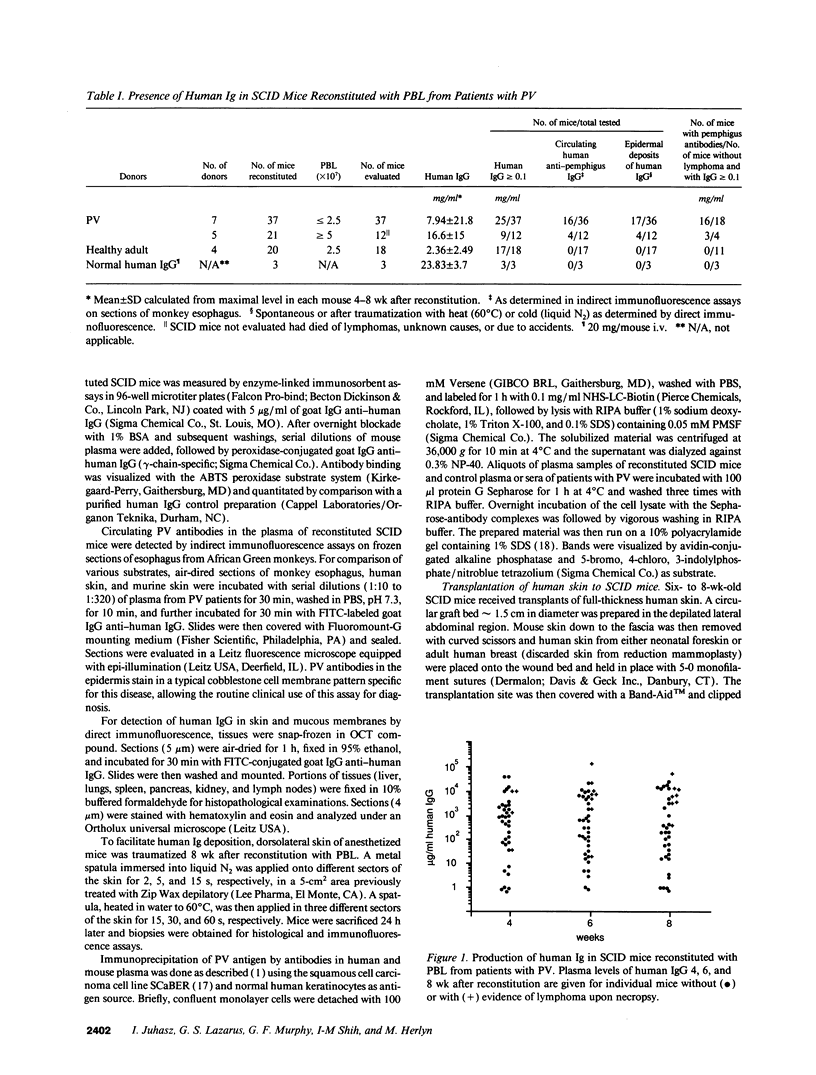
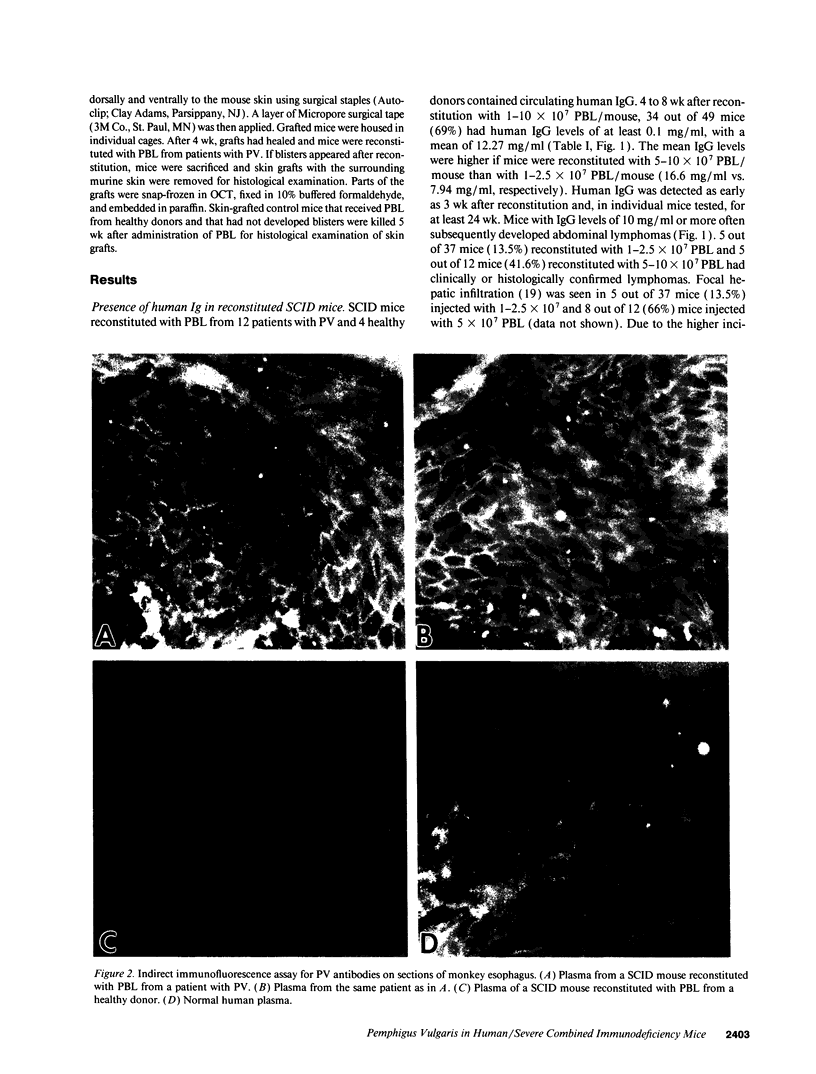
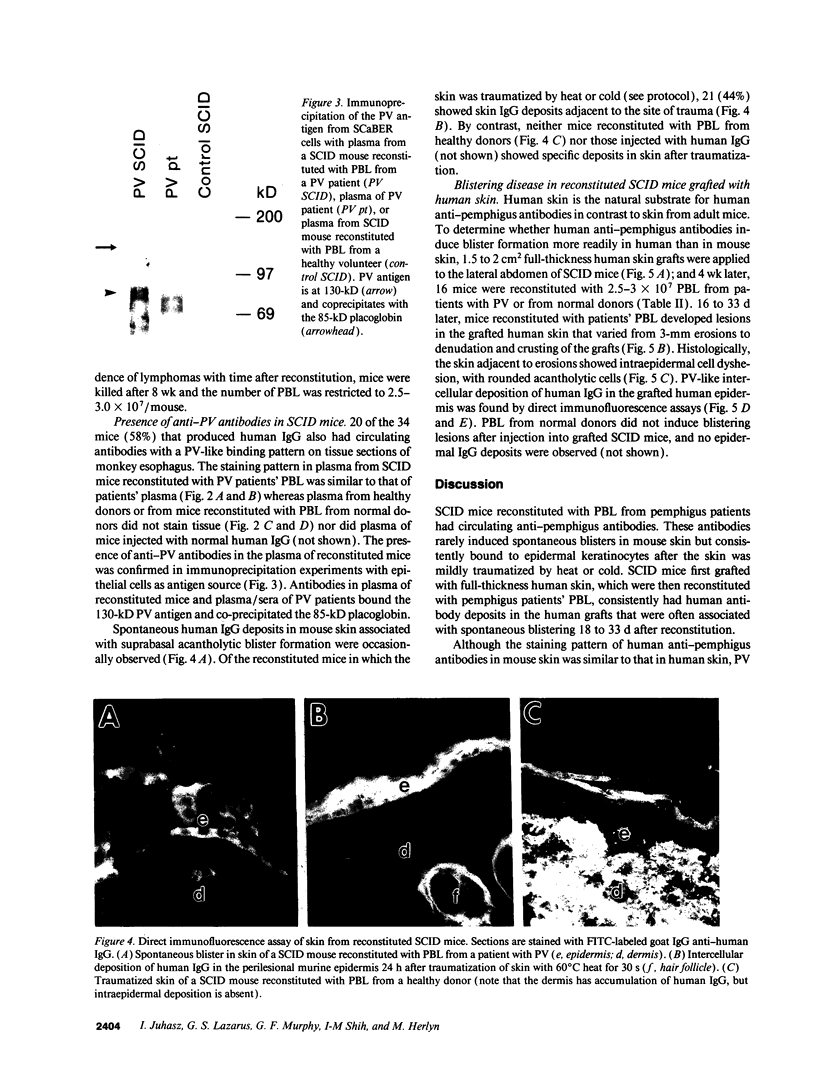
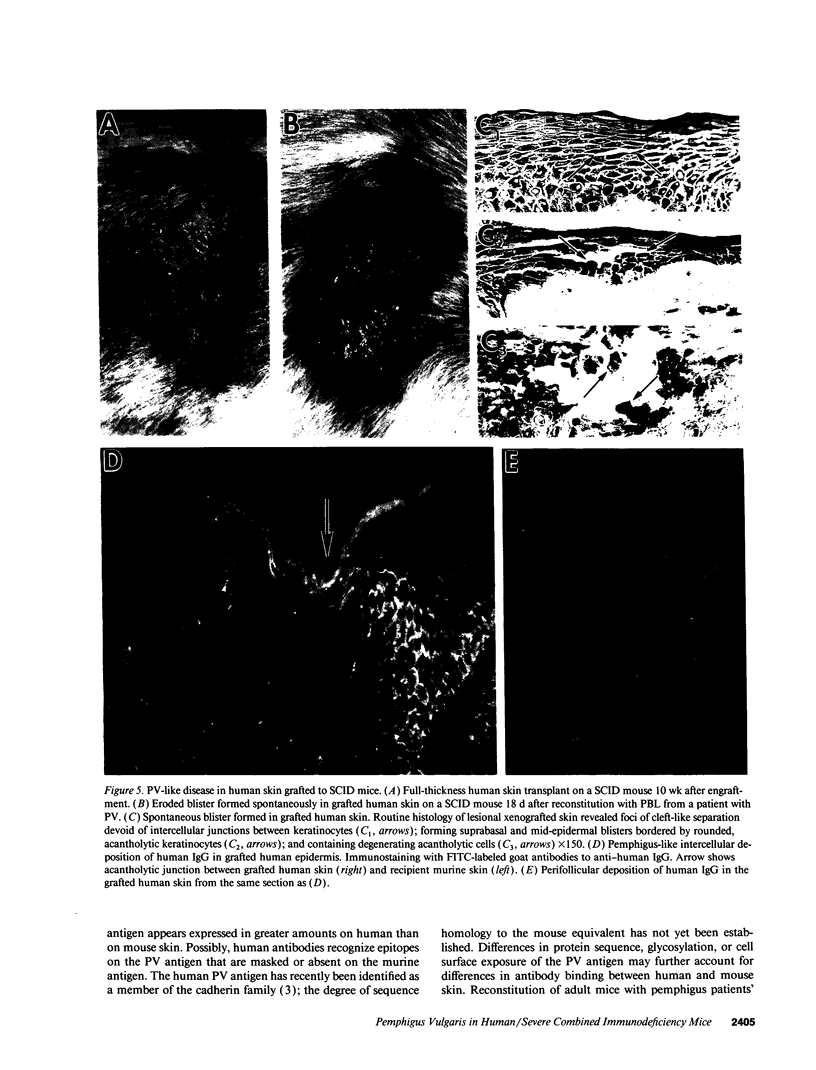
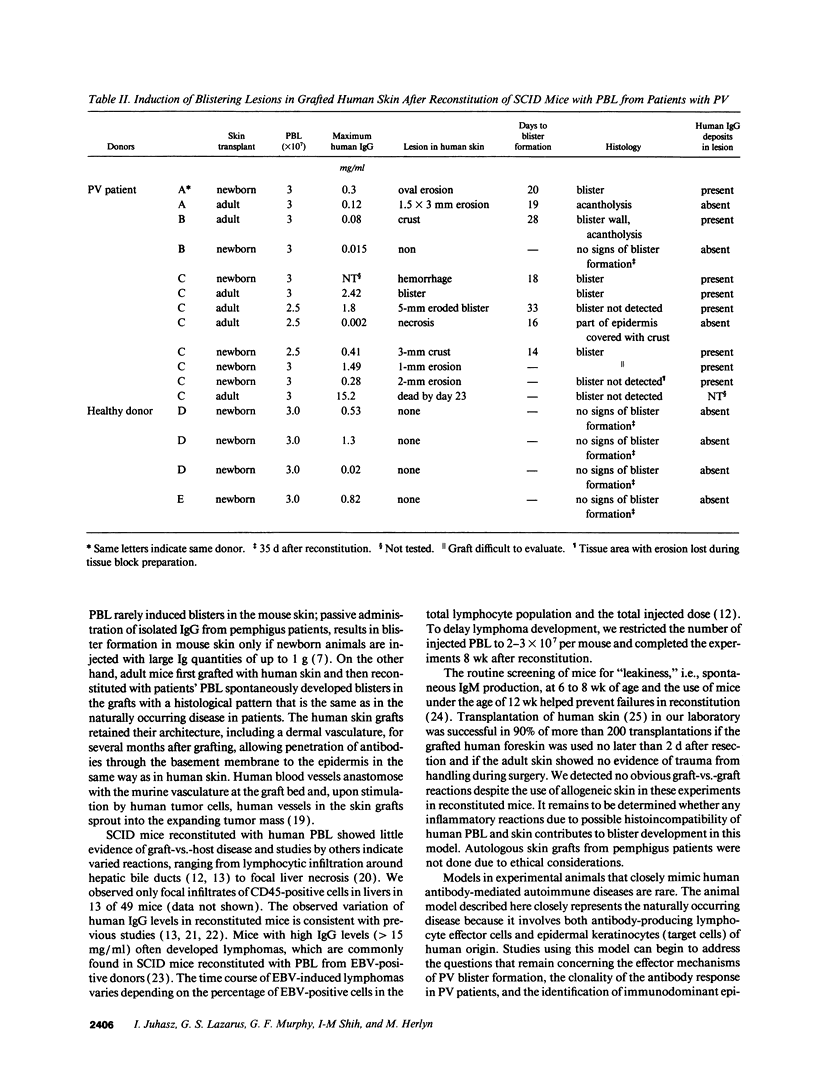
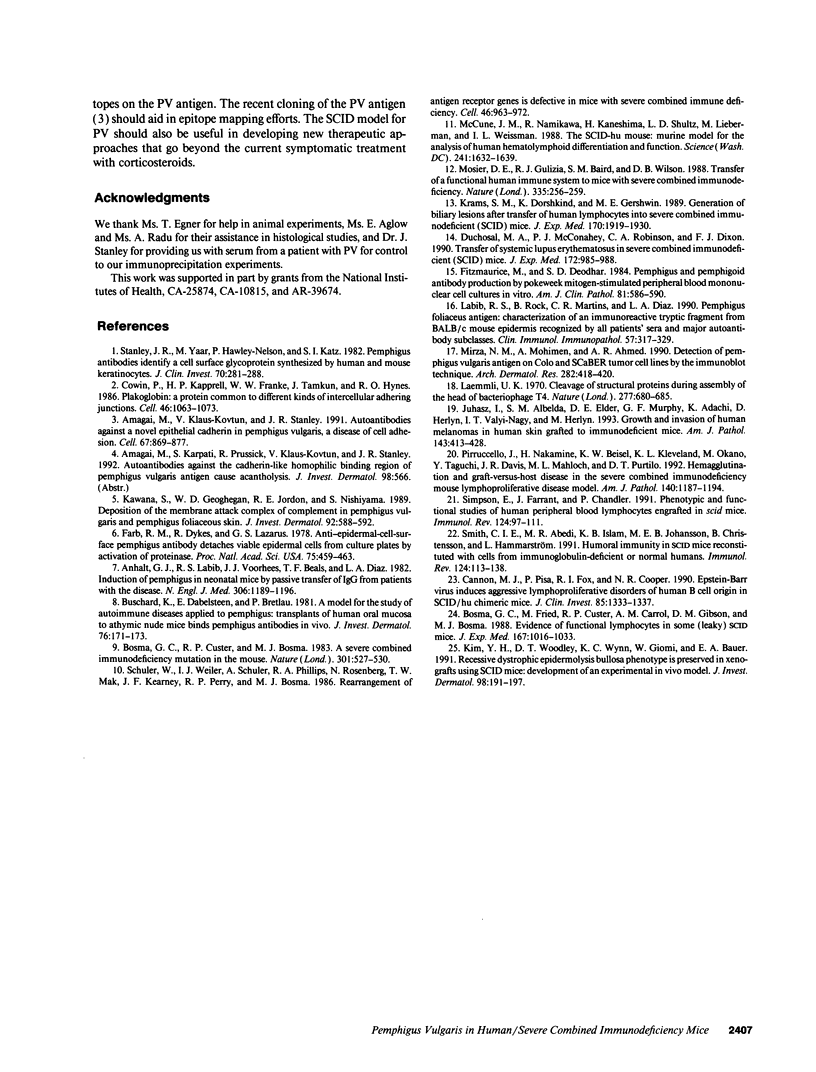
Images in this article
Selected References
These references are in PubMed. This may not be the complete list of references from this article.
- Amagai M., Klaus-Kovtun V., Stanley J. R. Autoantibodies against a novel epithelial cadherin in pemphigus vulgaris, a disease of cell adhesion. Cell. 1991 Nov 29;67(5):869–877. doi: 10.1016/0092-8674(91)90360-b. [DOI] [PubMed] [Google Scholar]
- Anhalt G. J., Labib R. S., Voorhees J. J., Beals T. F., Diaz L. A. Induction of pemphigus in neonatal mice by passive transfer of IgG from patients with the disease. N Engl J Med. 1982 May 20;306(20):1189–1196. doi: 10.1056/NEJM198205203062001. [DOI] [PubMed] [Google Scholar]
- Bosma G. C., Custer R. P., Bosma M. J. A severe combined immunodeficiency mutation in the mouse. Nature. 1983 Feb 10;301(5900):527–530. doi: 10.1038/301527a0. [DOI] [PubMed] [Google Scholar]
- Bosma G. C., Fried M., Custer R. P., Carroll A., Gibson D. M., Bosma M. J. Evidence of functional lymphocytes in some (leaky) scid mice. J Exp Med. 1988 Mar 1;167(3):1016–1033. doi: 10.1084/jem.167.3.1016. [DOI] [PMC free article] [PubMed] [Google Scholar]
- Buschard K., Dabelsteen E., Bretlau P. A model for the study of autoimmune diseases applied to pemphigus: transplants of human oral mucosa to athymic nude mice binds pemphigus antibodies in vivo. J Invest Dermatol. 1981 Mar;76(3):171–173. doi: 10.1111/1523-1747.ep12525667. [DOI] [PubMed] [Google Scholar]
- Cannon M. J., Pisa P., Fox R. I., Cooper N. R. Epstein-Barr virus induces aggressive lymphoproliferative disorders of human B cell origin in SCID/hu chimeric mice. J Clin Invest. 1990 Apr;85(4):1333–1337. doi: 10.1172/JCI114573. [DOI] [PMC free article] [PubMed] [Google Scholar]
- Cowin P., Kapprell H. P., Franke W. W., Tamkun J., Hynes R. O. Plakoglobin: a protein common to different kinds of intercellular adhering junctions. Cell. 1986 Sep 26;46(7):1063–1073. doi: 10.1016/0092-8674(86)90706-3. [DOI] [PubMed] [Google Scholar]
- Duchosal M. A., McConahey P. J., Robinson C. A., Dixon F. J. Transfer of human systemic lupus erythematosus in severe combined immunodeficient (SCID) mice. J Exp Med. 1990 Sep 1;172(3):985–988. doi: 10.1084/jem.172.3.985. [DOI] [PMC free article] [PubMed] [Google Scholar]
- Farb R. M., Dykes R., Lazarus G. S. Anti-epidermal-cell-surface pemphigus antibody detaches viable epidermal cells from culture plates by activation of proteinase. Proc Natl Acad Sci U S A. 1978 Jan;75(1):459–463. doi: 10.1073/pnas.75.1.459. [DOI] [PMC free article] [PubMed] [Google Scholar]
- Fitzmaurice M., Deodhar S. D. Pemphigus and pemphigoid antibody production by pokeweed mitogen-stimulated peripheral blood mononuclear cell cultures in vitro. Am J Clin Pathol. 1984 May;81(5):586–590. doi: 10.1093/ajcp/81.5.586. [DOI] [PubMed] [Google Scholar]
- Kawana S., Geoghegan W. D., Jordon R. E., Nishiyama S. Deposition of the membrane attack complex of complement in pemphigus vulgaris and pemphigus foliaceus skin. J Invest Dermatol. 1989 Apr;92(4):588–592. doi: 10.1111/1523-1747.ep12709624. [DOI] [PubMed] [Google Scholar]
- Kim Y. H., Woodley D. T., Wynn K. C., Giomi W., Bauer E. A. Recessive dystrophic epidermolysis bullosa phenotype is preserved in xenografts using SCID mice: development of an experimental in vivo model. J Invest Dermatol. 1992 Feb;98(2):191–197. doi: 10.1111/1523-1747.ep12555849. [DOI] [PubMed] [Google Scholar]
- Krams S. M., Dorshkind K., Gershwin M. E. Generation of biliary lesions after transfer of human lymphocytes into severe combined immunodeficient (SCID) mice. J Exp Med. 1989 Dec 1;170(6):1919–1930. doi: 10.1084/jem.170.6.1919. [DOI] [PMC free article] [PubMed] [Google Scholar]
- Labib R. S., Rock B., Martins C. R., Diaz L. A. Pemphigus foliaceus antigen: characterization of an immunoreactive tryptic fragment from BALB/c mouse epidermis recognized by all patients' sera and major autoantibody subclasses. Clin Immunol Immunopathol. 1990 Nov;57(2):317–329. doi: 10.1016/0090-1229(90)90045-r. [DOI] [PubMed] [Google Scholar]
- Laemmli U. K. Cleavage of structural proteins during the assembly of the head of bacteriophage T4. Nature. 1970 Aug 15;227(5259):680–685. doi: 10.1038/227680a0. [DOI] [PubMed] [Google Scholar]
- McCune J. M., Namikawa R., Kaneshima H., Shultz L. D., Lieberman M., Weissman I. L. The SCID-hu mouse: murine model for the analysis of human hematolymphoid differentiation and function. Science. 1988 Sep 23;241(4873):1632–1639. doi: 10.1126/science.241.4873.1632. [DOI] [PubMed] [Google Scholar]
- Mirza N. M., Mohimen A., Ahmed A. R. Detection of pemphigus vulgaris antigen on COLO and SCaBER tumor cell lines by the immunoblot technique. Arch Dermatol Res. 1990;282(6):418–420. doi: 10.1007/BF00372096. [DOI] [PubMed] [Google Scholar]
- Mosier D. E., Gulizia R. J., Baird S. M., Wilson D. B. Transfer of a functional human immune system to mice with severe combined immunodeficiency. Nature. 1988 Sep 15;335(6187):256–259. doi: 10.1038/335256a0. [DOI] [PubMed] [Google Scholar]
- Pirruccello S. J., Nakamine H., Beisel K. W., Kleveland K. L., Okano M., Taguchi Y., Davis J. R., Mahloch M. L., Purtilo D. T. Hemagglutination and graft-versus-host disease in the severe combined immunodeficiency mouse lymphoproliferative disease model. Am J Pathol. 1992 May;140(5):1187–1194. [PMC free article] [PubMed] [Google Scholar]
- Schuler W., Weiler I. J., Schuler A., Phillips R. A., Rosenberg N., Mak T. W., Kearney J. F., Perry R. P., Bosma M. J. Rearrangement of antigen receptor genes is defective in mice with severe combined immune deficiency. Cell. 1986 Sep 26;46(7):963–972. doi: 10.1016/0092-8674(86)90695-1. [DOI] [PubMed] [Google Scholar]
- Simpson E., Farrant J., Chandler P. Phenotypic and functional studies of human peripheral blood lymphocytes engrafted in scid mice. Immunol Rev. 1991 Dec;124:97–111. doi: 10.1111/j.1600-065x.1991.tb00618.x. [DOI] [PubMed] [Google Scholar]
- Smith C. I., Abedi M. R., Islam K. B., Johansson M. E., Christensson B., Hammarström L. Humoral immunity in scid mice reconstituted with cells from immunoglobulin-deficient or normal humans. Immunol Rev. 1991 Dec;124:113–138. doi: 10.1111/j.1600-065x.1991.tb00619.x. [DOI] [PubMed] [Google Scholar]
- Stanley J. R., Yaar M., Hawley-Nelson P., Katz S. I. Pemphigus antibodies identify a cell surface glycoprotein synthesized by human and mouse keratinocytes. J Clin Invest. 1982 Aug;70(2):281–288. doi: 10.1172/JCI110615. [DOI] [PMC free article] [PubMed] [Google Scholar]







